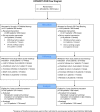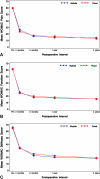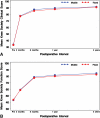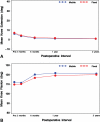The John Insall Award: no functional advantage of a mobile bearing posterior stabilized TKA
- PMID: 22006197
- PMCID: PMC3238000
- DOI: 10.1007/s11999-011-2114-5
The John Insall Award: no functional advantage of a mobile bearing posterior stabilized TKA
Abstract
Background: Mobile bearing (MB) total knee design has been advocated as a means to enhance the functional characteristics and decrease the wear rates of condylar total knee arthroplasty (TKA). However, it is unclear if these designs achieve these goals.
Questions/purposes: We asked whether function of patients or survivorship would be greater or complications would be lesser in groups of patients with MB compared with fixed bearing (FB) TKA. We also sought to describe retrieval findings.
Methods: We randomized 507 primary TKAs in 416 eligible patients to receive MB (n = 252) or FB (n = 255) devices from November 2001 to August 2007 (Investigational Device Exemption G000180, ClinicalTrials.gov registration number NCT00946075). Patients were blinded to treatment allocation. WOMAC Index, SF-12 Health Survey, knee range of motion, and Knee Society scores were collected and compared preoperatively and at 6, 12, and 24 months postoperatively. We recorded device failures and complications until October 2009. Kaplan-Meier survivorship was compared using the log rank test. Twelve retrieved MB devices underwent pathologic analysis. The minimum postoperative time was 2.2 years (mean, 5.9 years; range, 2.2-7.9 years).
Results: We found no differences in mean clinical assessment scores or mean score changes from baseline at any postoperative interval through 2 postoperative years. Nineteen of the 252 MB and 13 of the 255 FB knees had undergone revision of any component. Estimated survival at 6 postoperative years was similar for the two devices: 90.1% (95% confidence interval [CI], 84.1-93.9) for MB and 94.2% (95% CI, 90.1-96.6) for FB. Two MB and no FB tibial components were revised for loosening. There was one case of MB insert dislocation. Retrieved MB devices demonstrated no unexpected wear or mechanical device failures.
Conclusion: We found no evidence of functional advantage of the MB design. Survivorship was similar, although the study is limited by short duration of followup.
Figures






Similar articles
-
The 2018 Mark Coventry, MD Award: Does a Ceramic Bearing Improve Pain, Function, Wear, or Survivorship of TKA in Patients Younger Than 55 Years of Age? A Randomized Trial.Clin Orthop Relat Res. 2019 Jan;477(1):49-57. doi: 10.1007/s11999.0000000000000271. Clin Orthop Relat Res. 2019. PMID: 30794228 Free PMC article. Clinical Trial.
-
2017 Chitranjan S. Ranawat Award: Does Computer Navigation in Knee Arthroplasty Improve Functional Outcomes in Young Patients? A Randomized Study.Clin Orthop Relat Res. 2018 Jan;476(1):6-15. doi: 10.1007/s11999.0000000000000000. Clin Orthop Relat Res. 2018. PMID: 29389753 Free PMC article. Clinical Trial.
-
No long-term difference between fixed and mobile medial unicompartmental arthroplasty.Clin Orthop Relat Res. 2012 Jan;470(1):61-8. doi: 10.1007/s11999-011-1961-4. Clin Orthop Relat Res. 2012. PMID: 21732024 Free PMC article.
-
No differences between fixed- and mobile-bearing total knee arthroplasty.Knee Surg Sports Traumatol Arthrosc. 2017 Jun;25(6):1757-1777. doi: 10.1007/s00167-016-4195-x. Epub 2016 Jun 20. Knee Surg Sports Traumatol Arthrosc. 2017. PMID: 27324479 Review.
-
Superior Mid- to Long-Term Clinical Outcomes of Mobile-Bearing Total Knee Arthroplasty Compared to Fixed-Bearing: A Meta-Analysis Based on a Minimum of 5 Years of Study.J Knee Surg. 2021 Oct;34(12):1368-1378. doi: 10.1055/s-0040-1709490. Epub 2020 Jun 5. J Knee Surg. 2021. PMID: 32503063
Cited by
-
No difference between mobile and fixed bearing in primary total knee arthroplasty: a meta-analysis.Knee Surg Sports Traumatol Arthrosc. 2022 Sep;30(9):3138-3154. doi: 10.1007/s00167-022-07065-5. Epub 2022 Jul 21. Knee Surg Sports Traumatol Arthrosc. 2022. PMID: 35861866 Free PMC article. Review.
-
Increased risk of aseptic loosening for 43,525 rotating-platform vs. fixed-bearing total knee replacements.Acta Orthop. 2017 Dec;88(6):649-656. doi: 10.1080/17453674.2017.1378533. Epub 2017 Sep 20. Acta Orthop. 2017. PMID: 28929828 Free PMC article.
-
In vivo kinematics of high-flex mobile-bearing total knee arthroplasty, with a new post-cam design, in deep knee bending motion.Int Orthop. 2012 Dec;36(12):2465-71. doi: 10.1007/s00264-012-1673-8. Epub 2012 Oct 19. Int Orthop. 2012. PMID: 23081946 Free PMC article.
-
Mobile bearing and fixed bearing total knee arthroplasty.Ann Transl Med. 2016 Apr;4(7):127. doi: 10.21037/atm.2015.12.64. Ann Transl Med. 2016. PMID: 27162777 Free PMC article. Review.
-
Clinical Benefit of Robotic-Assisted Total Knee Arthroplasty over Conventional Total Knee Arthroplasty When Using Mobile-Bearing Implants.Medicina (Kaunas). 2024 Jul 6;60(7):1103. doi: 10.3390/medicina60071103. Medicina (Kaunas). 2024. PMID: 39064532 Free PMC article.
References
-
- Argenson JN, O’Connor JJ. Polyethylene wear in meniscal knee replacement. A one to nine-year retrieval analysis of the Oxford knee. J Bone Joint Surg Br. 1992;74:228–232. - PubMed
-
- Bellamy N, Buchanan WW, Goldsmith CH, Campbell J, Stitt LW. Validation study of WOMAC: a health status instrument for measuring clinically important patient relevant outcomes to antirheumatic drug therapy in patients with osteoarthritis of the hip or knee. J Rheumatol. 1988;15:1833–1840. - PubMed
Publication types
MeSH terms
Associated data
LinkOut - more resources
Full Text Sources
Medical
Miscellaneous

